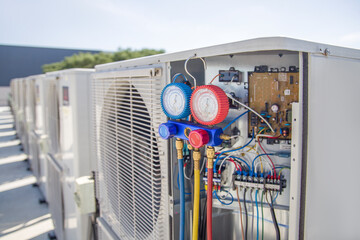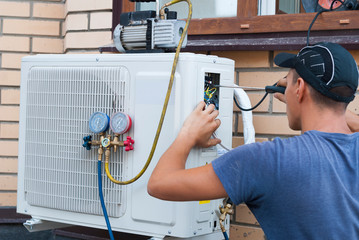HVAC systems keep homes and businesses warm and cozy in the winter and cool and comfortable in the summer. They also help filter air and maintain proper humidity levels.

A home’s heating system keeps it warm during the winter. The most common type of heating system used in the US is a forced air furnace, which uses ducts to distribute hot or cold air throughout the house. It can be powered by natural gas, oil or electricity. Many homeowners opt for a hybrid system, which utilizes a furnace and a heat pump. This can be more energy efficient than a traditional system and is good for warmer climates that don’t experience extreme temperatures.
Boilers are another common type of home heating system. These systems heat water using either gas propane or electricity. Pipes then carry this heated water to radiators, which heat the air in the home. Heat pumps are a newer kind of home heating system that can both heat and cool the home. They do this by using refrigerant to absorb, transport and release heat. They can also reverse the flow of this refrigerant to provide cooling in the summer.
Ventilation systems are also important in keeping a house at the right temperature and providing quality indoor air. HVAC professionals can recommend and install ventilation systems that meet your needs and budget.
The final component of an HVAC system is the thermostat, which controls the entire system. When the thermostat senses that it’s time to change the temperature, it signals the other units in the system to start working. The resulting warm or cool air is distributed through the ductwork or an air handler, depending on the type of system you have.
You may have heard the terms AC and HVAC used interchangeably, but they’re actually different things. An air conditioner only cools the air, while an HVAC system does that and also heats it and ventilates it. If you’re in the market for a new unit, make sure your contractors use the correct terminology. Otherwise, you could end up with an improperly sized or installed system that’s not operating at peak performance.
Cooling
While heating uses combustion to warm air, cooling involves pulling heat from the surrounding environment. This process, known as sensible heat transfer, can be accomplished with a variety of methods. For example, an air conditioning system may use a series of fans to move air through a condenser. The hot, moist air then exits through vents. The energy required to do this is considerable. Moreover, it also increases electricity consumption. Fortunately, new technology reduces the environmental impact of cooling while increasing efficiency.
HVAC systems have many components that work together to make your home comfortable. Some of the most important are furnaces, blower motors and ductwork that help distribute both heated and cooled air. An HVAC unit may also include an air conditioner and other units like humidifiers or air purifiers. The system is controlled by a thermostat and can be powered by gas, oil, electricity or other sources.
The main goal of an HVAC system is to provide good indoor air quality (IAQ) through adequate ventilation with filtration and thermal comfort. Ventilation and filtration are essential to the health of the people living in a building as well as the equipment. The IAQ of a space can be affected by many factors including temperature, humidity, outdoor pollution levels and precipitation.
A heat pump HVAC system can both heat and cool a space by using a refrigerant to absorb, transport and release heat. This system can also reverse the flow of the refrigerant when it is necessary to do so for heating. Heat pump systems are an excellent choice for climates that experience moderate temperatures.
Another popular type of HVAC system is the packaged unit that includes a heat pump, air conditioning and sometimes even an exhaust system for releasing moisture. Generally, these systems are smaller and less expensive than other types of HVAC systems but can still produce the same comforts. For this reason, some people choose to use them in places that experience a wide range of weather conditions and temperatures. However, for best results and efficiency, a fully integrated system is recommended.
Humidity Control
Humidity Control
Whether you live in a damp climate or a dry one, achieving the indoor humidity “sweet spot” is essential to comfort, health and even structural longevity. The perfect relative humidity environment — that 40 to 60% sweet spot — reduces airborne bacteria, germs, viruses and biological organisms that can spread illness or worsen respiratory conditions.
The ideal humidity range also eliminates condensation, mold/mildew growth, wood deterioration and loss of insulation properties. It can also increase the life of equipment and reduce the risk of fire hazards.
Maintaining proper moisture levels in a facility is an important step to ensure compliance with industry standards and safety regulations, as well as product quality and reliability. High humidity creates an atmosphere where electrostatic energy can build up and spark, making it unsafe for working near electrical components. Additionally, low humidity can cause materials to become brittle and weaken over time.
Humidity control is achieved primarily through a combination of humidifiers and dehumidifiers, which are installed in a space’s HVAC system. A humidifier pumps water vapor into the air to raise the humidity, while a dehumidifier removes excess moisture to lower the humidity. Unlike portable units, these systems are connected to the HVAC system, and they operate year-round to manage the humidity in your home or facility.
Many factors contribute to indoor humidity, including outdoor conditions, seasonal weather and your local climate. The design and construction of your space, occupants’ daily activities and habits, and varying levels of airtightness and ventilation can also affect the amount of moisture in the air. In addition, your HVAC system’s compressor cycle and supply discharge temperature impact the humidity as it is being controlled.
Humidity management is an essential part of HVAC, but the best approach to maintaining a safe and comfortable atmosphere involves dedicated humidity control solutions. These include hygrometers, which monitor the moisture content of the air, and specialized systems that can accurately target humidity and dehumidify. For instance, humidity control systems that employ adiabatic cooling and use a dehumidifier and humidifier simultaneously can maintain a precise indoor relative humidity value and prevent energy waste.
Ventilation
The HVAC system brings outdoor air into the house and circulates it throughout. This helps to control indoor humidity, as well as reducing the levels of dust, gasses, odors and infectious bacteria and viruses. The amount of ventilation required varies by climate. For example, in warm and humid environments, where interstitial condensation is a problem, positive pressure mechanical ventilation systems may be needed to reduce the level of moisture. In cold climates, where exfiltration should be minimized to avoid heat loss, negative pressure ventilation is often used.
The system consists of an air conditioner, furnace, air handler, ductwork, thermostat and other units like a humidifier or air purifier. Depending on the type of home and climate, the air conditioner and furnace may be combined into one unit, called a heat pump. Heat pumps use refrigerant to absorb, transport and release heat. They can change between heating and cooling modes and are powered by electricity.
In general, HVAC systems are designed to provide an ideal temperature and humidity for a space. The thermostat controls the overall operation of the system, directing the flow of air according to the desired temperature. In some homes, the thermostat is linked to a humidity sensor so that the system can react to changes in the ambient temperature and humidity.
Proper ventilation is essential for a healthy environment. Without it, the indoor air can build up high levels of moisture, odors, gases and dust particles. The lungs need fresh air from the outside to dilute these indoor pollutants. Most residential forced air-heating and air-conditioning systems do not bring in outdoor air mechanically; infiltration and natural ventilation are used to do this. Advanced designs for new homes are starting to include a mechanical ventilation feature that brings in outdoor air, using an energy efficient heat recovery ventilator. This helps to keep the house cool in summer, and warm in winter. It also cuts down on the need for filter maintenance and static pressure drop, which saves power. Infiltration and natural ventilation can still be used to supplement these systems as well.
